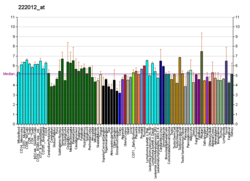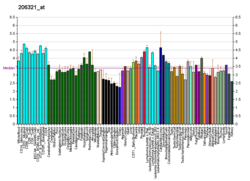Function
The protein encoded by this gene is structurally related to regulatory factors X2, X3, X4, and X5. It is a transcriptional activator that can bind DNA as a monomer or as a heterodimer with RFX family members X2, X3, and X5, but not with X4. This protein binds to the Xboxes of MHC class II genes and is essential for their expression. Also, it can bind to an inverted repeat that is required for expression of hepatitis B virus genes. [7] The RFX proteins were originally cloned and characterized due to their high affinity for a cis-acting promoter sequence, called the Xbox, found in all MHC class II genes. [6]
Levels of mRNA encoding this protein as well as RFX2 and RFX3 are found to be consistently elevated in the testis and are variable in other tissues throughout the body. [6]
RFX1 contains a C-terminal sequence with no apparent homology to other RFX proteins. This C-terminal tail contains an acidic region that is thought to aid in crossing the nuclear membrane. Two major functions are hypothesized to this exist for this domain: a contribution to the nuclear localization signal (NLS) as well as the contradictory down-regulation of DNA binding as well as nuclear association. These two functions were originally identified through sequence mutations and translational fusions with gfp (green fluorescent protein) and remain to be confirmed. [11]
This page is based on this
Wikipedia article Text is available under the
CC BY-SA 4.0 license; additional terms may apply.
Images, videos and audio are available under their respective licenses.







